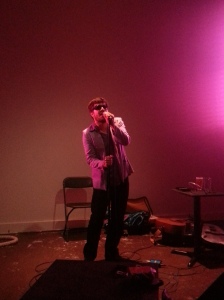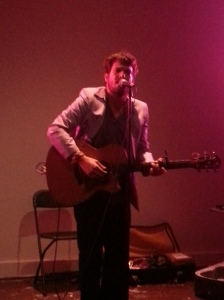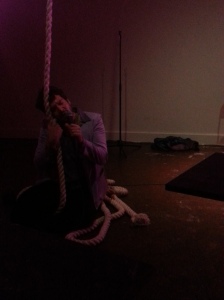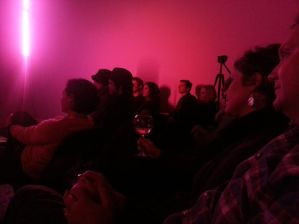 John Elliott’s songs appeared on the television shows “Grey’s Anatomy” and “One-Tree Hill.” He even co-wrote a song within one episode of “Californication.” Yet, for most of his career, John remained an independent artist.
John Elliott’s songs appeared on the television shows “Grey’s Anatomy” and “One-Tree Hill.” He even co-wrote a song within one episode of “Californication.” Yet, for most of his career, John remained an independent artist.
“It’s a serious balancing act,” explained the San Francisco-based singer-songwriter. When I asked him about the benefits and challenges of staying independent in the music industry, John honestly and humbly answered, “Sometimes the benefits outweigh the challenges and sometimes it’s the other way around. I’ve mainly stayed independent because… I just haven’t met the right people yet. Actually, I might have just met the right people the other day. We’ll see how that goes.”
He adds, “I do have someone working with me who started as a fan, and now because she believes in what I make and I [in turn] believe in her, she has become a valuable member of the team. I think that’s a rare relationship to find. I would love to continue to build a team, but it has to be with the right people.”
Since high school, during his first attempt to write music on a blank tape from 1993, John knew he wanted to pursue music as a career. So far, he has entirely self-produced all his records, including his latest Good Goodbyes – the first record on which he played every instrument, and the one that perhaps presented the most challenges. Now, as he continues the journey he started long ago, John Elliott reflects on the radical experience of relying solely on himself to bring his music to fruition. It is my pleasure to welcome John as the featured artist for the month of March on Music Historian’s Hear, Let’s Listen.
In the title track of his record, which is composed in a major key, John sings the following lyric, “I can’t let a good thing go even when it starts to bleed,” followed by, “Even when I know it’s dying and it’s time to set if free/ I’m afraid I won’t be treasured/the way she treasures me.” John wrote this song in 10 minutes one morning, without even writing the lyrics down.
He says, “I don’t question songs that come [to me] like that. They are just pure and right. If I look at it now and try to analyze it, I would say it’s [the song] about moving on from something without knowing what’s next, which is a scary thing to do. People always say “let it go, let it go” as if that’s something safe or easy. I think it’s a little disingenuous to claim you can just lightly skip into the future, unencumbered by the past, never to return or look back or wonder.”
“Of course,” he continues, “the album is called Good Goodbyes, so I understand that moving on and elsewhere can be, and often is, a good thing. The rest of album definitely lives under the umbrella of that song.”
As a critic, I find it comforting when the title track of the artist’s album is born with little effort and yet holds so much meaning that analyzing the lyrics might take 10 days.
John confirms, “It’s not about how “easy” it is to write something, it’s about how right if feels. I know when I write well, with honesty, passion and heart. When I try too hard, it’s no good.”
Other songs on his album like “Yin and Yang Collector,” “Monogamous” and “Friends Back East” seem to tell a definite story. I wondered whether these songs had a story and whether John spent more time trying to write them compared to “All These Good Goodbyes.”
“Generally, it’s doesn’t go well if I start by trying to write something with a message. That’s tricky. It’s better if the story, images, or lines are strung together by emotional truth of some sort. If you get that right, a message “might” emerge. The best writing is a little mysterious, but somehow makes perfect sense to your soul. You have to get your head out of the way and let your heart hear it,” explains John. 
John describes the lyrics on his album more as poetry than storytelling. He also recalls a moment when he performed another one of his songs from Good Goodbyes, “Still I’m Not Still” for a producer. “That’s not a song,” remarked the producer, “that’s a meditation.” While John admits the producer might have meant to say this as a negative remark, John received it openly and happily. He claims “I loved it.”
Like most artists who perfect their craft (and the art of letting a song take its form without exercising too much control is one of the ways to be perfect), John has written, and rewritten a myriad of songs that did not make his latest record. By the time a song does make it on his album, he has “obsessed over every line” both lyrical and musical.
Listeners, of course, are another important part to any musical experience, and John’s music is no exception. “Every listener brings his or her own unique perspective to the experience, and might hear something radically different than what you intended,” adds the artist.
In the case of Good Goodbyes, I couldn’t help but feel that John really went out on a limb and made himself very vulnerable, especially since he was the sole creative and functional driver of this record. On his past albums, John included a number of different players in the process. He claims the making of his latest record “happened during a very solo time in my life and as the process of creating it continued, I realized it was important to me that I remained true to that.
“It’s quite unnerving to rely solely on your own intuition with creative choices that have no objective basis. It’s also, eventually, quite satisfying.”
Good Goodbyes also taught John how much he relies on other people for approval about his music. Although he enjoyed the experience of producing and only answering to himself, he still needed a second set of ears. After putting the record through seven revisions, John invited mastering engineer JJ Golden to help frame the final product.
“I tried to bring all the disparate pieces and sounds together into something cohesive,” he explains. “It’s a collage, and it has some sonic flaws, but hopefully that gives it character.”
Watching John during one of his live shows on his nation-wide tour back in November, I listened to and watched an artist whose music brought a character out of him, one who believes in himself so much and manages to attract an audience that believes in his sound and performance.
I walked in to Cantina Royal, a restaurant in Williamsburg just in the nick of time to see John Elliott. Secured with a Brooklyn Lager, I traveled down a red-light lit hallway to a performance space behind a gritty grey door.
In this performance space, there was no stage but a clear floor. There was plenty of room for audiences to take seats in rows of mobile chairs and mini tables. Pink and blue lights covered the space designated for acts. In the far left corner of the room, I noticed the uncanny detail of a rope that extended from the high ceiling and coiled out on the floor.
Most chairs were filled, and the only available seat was at a table occupied by a couple. As I sat down and prepped myself for a night of intense observation and musical analysis, I occasionally peeked at the flirtatious exchanges between the man and the woman next to me. Underneath the table, the guy caressed his girlfriend’s bare knee as she sketched a picture on some scrap paper. Both shared a package of very low caloric snack of seaweed sheets. Perhaps they decided this food paired well with beer? I was not sure whether this combination was romantic or strange.
Returning to John’s performance set, I knew I was in for a performance I would never forget. And I was right.
During his song “Monogamous,” which is primarily built on ambiance created by electrical and synthesized instruments playing held out notes, there is a long period in which John does not sing. On the record, the artist can get away with this, in a performance it is a different story. John knew he had to fill up that silence with something, so he started to swing on a rope in the far left corner of the room; a move several audience members found amusing. 
For his next song “Yin and Yang Collector,” John had a costume change. He dressed as a king, one that somebody might find in a frat house in New Orleans as opposed to one in a dramatic film about Henry VIII. During this song, he picked up his guitar and started playing like a true singer songwriter. But, I soon learned the surprises were not yet over.
John did not finish “Yin and Yang Collector.” Instead, he looped into another song, a cover of “Somewhere Over the Rainbow,” then transitioned back to “Yin and Yang Collector.” An artist successfully and easily accomplishes this only when the tonic of another song is the dominant or the predominant of the song they initially sing. This makes for easy modulation, and often, one will not find artists doing this during a performance but rather in their private time practicing.
 As I looked back to the couple, I noticed the woman started sketching a new picture, one of a masked face that imitated the appearance of John’s costume. It made sense then and there that something about John’s performance successfully captivated the imagination of one and perhaps multiple members in the public.
As I looked back to the couple, I noticed the woman started sketching a new picture, one of a masked face that imitated the appearance of John’s costume. It made sense then and there that something about John’s performance successfully captivated the imagination of one and perhaps multiple members in the public.
When I asked John what audience members said about his music during his tour, he remarked that most of what he heard has been “positive!” That or complete silence,” he adds. “A few people said it’s their new favorite. One person told me how much they liked this album more than the last.
“I just finished a show in Bellingham, Washington. Someone told me [I put on] the most entertaining show they’ve ever seen, so that was nice. But really, I have to remind myself to make what feels right to me and then let it go.”
John recalls a few moments from his tour in which listeners did not enjoy his set. During his show at Cantina, he humorously told the audience about the reception of one of his songs.
“This song went well in Austin, but horribly in Oregon because it was a song about people in Austin. Then it went well in Pennsylvania.”
Humor is just part of John’s nature, it is no way a coping method of dealing with the downsides of being a musician. Sharing your creation with the world comes with the territory, and that is why so many individuals who probably have songwriting talent will not pursue anything with music. Luckily, John understands this territory well, having traveled it before. He claims:
“The album is out there now. I hope people listen to it and like it. I’m very proud of it… And I’m thinking about what to make next.”
Currently, John is in between touring for Good Goodbyes. His agent is currently booking shows in the Midwest for 2014. In the meantime, he tackles the toughest component of any business plan, the marketing of his product. 
“Promotion is the greatest challenge of releasing an album independently. Truth is, I had some good plans in place, and then I went on tour and lost track of things. I want more people to hear it… I funded this album myself with savings from tours and other music income.”
When I asked him about the most important lesson he learned about being an artist and a businessman, he openly claimed, “The most important lesson I’ve learned as an artist is that everything happens in waves and you must learn to ride them. The most important lesson I learned as a businessman is that I’m learning as I go, and sometimes I luck into great decisions. In general… I need help on that side.”
John’s story of making and promoting Good Goodbyes is honest. It reminds listeners that like heroes in our favorite novels and films; if a musician does not go through any struggle, whether it is letting go of an old relationship, a bad habit or faulty belief, or a challenge of understanding business or making music, there is no reason for that listener to care about the artist. As for John’s music on Good Goodbyes, which is now available on iTunes, his website http://thehereafterishere.com/recordings, on Spotify, and, of course, at his live shows, the album will draw listeners into his world of expression, one that reaches the soul on an esoteric yet comforting level. Perhaps it is no surprise why his songs appeared in the hit television shows among audiences that fall within the 25 – 40 year age range. John presents us with something worth listening to, but we have to get out head out of the way and let our hearts hear it first.
